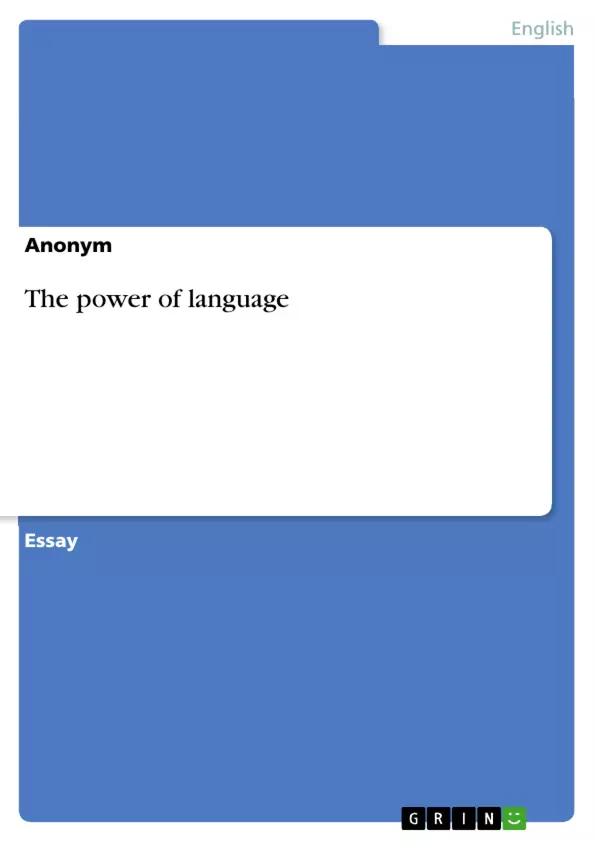How inherently different representations of the same event in media can be, due to ideological linguistic choices, shall be demonstrated in this essay. Furthermore, it will be pointed out why these choices are problematic and what impact they can have on consumers of news. In order to do so, a newspaper article about an industrial dispute in higher education from the Daily Mail1 and an article about the same event by the Guardian, both published on 22nd February 2018, will be scrutinised from a critical linguistic perspective. The analysis shall focus on differing patterns of transitivity, representation of social actors and naming practices.
Table of Contents
- Language and Power
Objectives and Key Themes
This essay aims to demonstrate how different linguistic choices in news reporting can shape the reader's perception of events. It analyzes two news articles covering the same industrial dispute, comparing their approaches to transitivity, representation of social actors, and naming practices to highlight the ideological implications of these choices.
- The impact of linguistic choices on news representation.
- Analysis of transitivity in news discourse.
- The role of social actor representation in shaping reader perception.
- The influence of lexical choices and vocabulary on conveying ideology.
- The manipulation of reader perception through selective quoting.
Chapter Summaries
Language and Power: This chapter analyzes two news articles from the Daily Mail and The Guardian covering a university lecturer's strike. The analysis focuses on how different linguistic choices in each article shape the reader's understanding of the event. The Daily Mail frames the story around students demanding refunds, portraying them as the primary actors causing trouble. The Guardian, in contrast, centers the narrative on the lecturers' strike action, highlighting the reasons behind the strike and the students' support for the lecturers. The chapter uses transitivity analysis to demonstrate how the choice of verbs and actors shapes the narrative, impacting reader perception of responsibility and agency. It further explores how the selection of lexical items and quotes reinforces these differing ideological stances. The analysis reveals how subtle linguistic variations can significantly influence how readers understand the same event, illustrating the power of language to shape public opinion and potentially manipulate understanding. The chapter emphasizes the interconnectedness of language and thought, arguing that linguistic choices aren't neutral but carry ideological weight, influencing how readers perceive reality.
Keywords
Language, power, news discourse, ideology, transitivity, social actors, lexical choices, representation, media bias, critical linguistics, news reporting, reader perception, manipulation.
FAQ: Comprehensive Language Preview
What is the main focus of this language preview?
This preview offers a comprehensive overview of an essay analyzing how linguistic choices in news reporting shape reader perception. It focuses on the ideological implications of these choices, using a case study of two news articles covering the same industrial dispute.
What are the key themes explored in the essay?
The key themes include the impact of linguistic choices on news representation, analysis of transitivity in news discourse, the role of social actor representation, the influence of lexical choices and vocabulary, and the manipulation of reader perception through selective quoting.
What specific linguistic features are analyzed?
The analysis delves into transitivity (the choice of verbs and actors), representation of social actors (who is presented as the main subject), lexical choices (vocabulary used), and the selection of quotes used in the news articles.
What case study is used in the essay?
The essay analyzes two news articles from different publications (Daily Mail and The Guardian) covering a university lecturer's strike. The comparison highlights how similar events can be presented very differently depending on linguistic choices.
How does the essay demonstrate the power of language?
By comparing the linguistic choices in the two news articles, the essay demonstrates how subtle variations in language can significantly influence how readers understand the same event. It illustrates the power of language to shape public opinion and potentially manipulate understanding, emphasizing the interconnectedness of language and thought.
What are the key findings of the analysis?
The analysis reveals how different linguistic choices frame the narrative in distinct ways. For example, one article might highlight student demands for refunds, portraying them as the primary problem, while another emphasizes the lecturers' reasons for striking and students' support for the lecturers. This highlights the non-neutrality of language and its ideological implications.
What are the keywords associated with this essay?
Keywords include: Language, power, news discourse, ideology, transitivity, social actors, lexical choices, representation, media bias, critical linguistics, news reporting, reader perception, manipulation.
What is included in this language preview?
This preview provides the title, table of contents, objectives and key themes, chapter summaries, and keywords of the essay.
What is the purpose of the essay?
The essay aims to demonstrate how different linguistic choices in news reporting can shape the reader's perception of events.
What chapter summaries are provided?
The preview includes a summary of the chapter "Language and Power," which details the analysis of the two news articles on the university lecturer's strike, focusing on how linguistic choices shape reader understanding of the event and its actors.
- Arbeit zitieren
- Anonym (Autor:in), 2018, The power of language, München, GRIN Verlag, https://www.grin.com/document/991071



